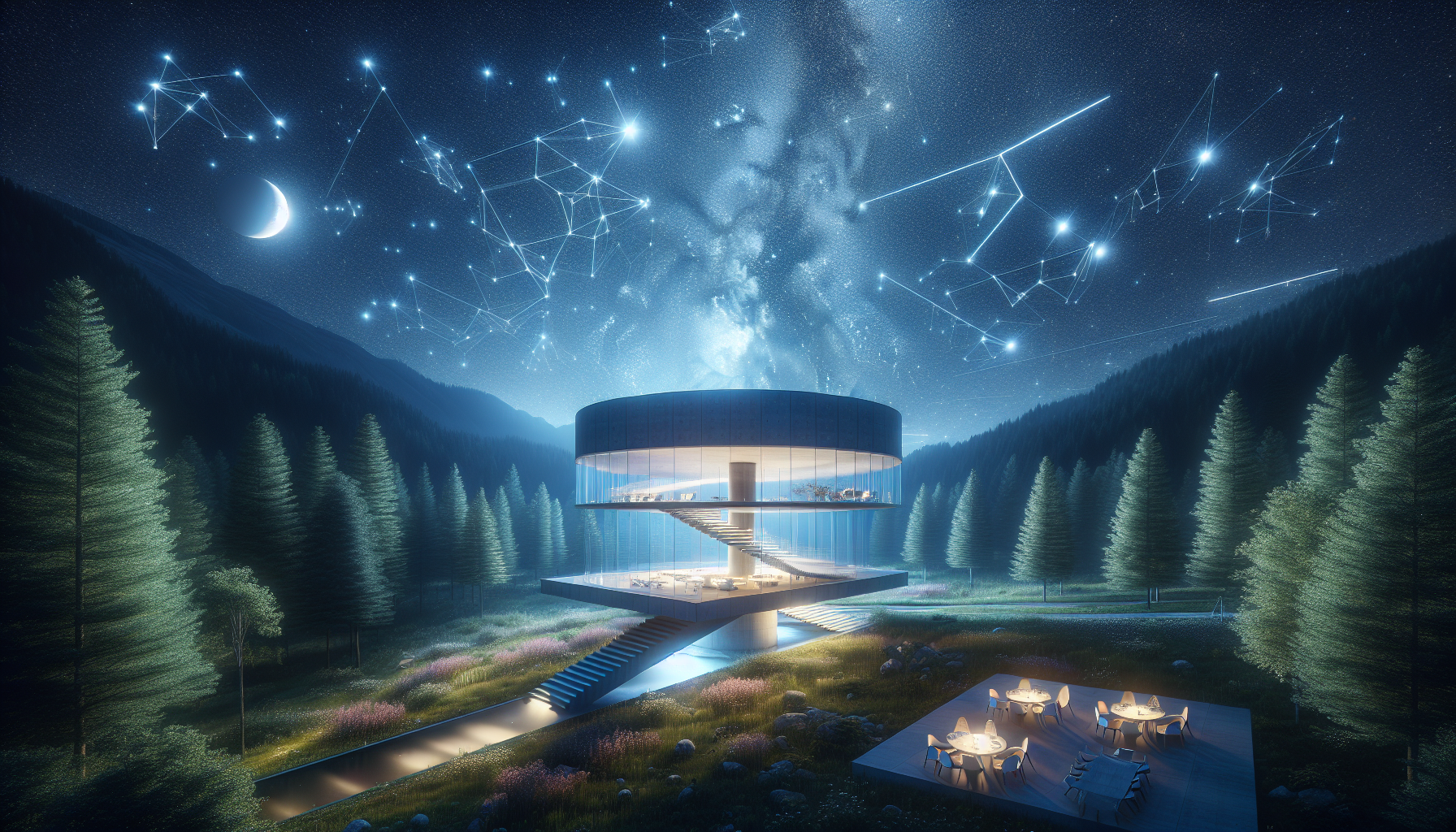In an era where technology often overshadows the natural wonders of the universe, there exists a profound movement that seeks to reconnect us with the celestial dance that has fascinated humanity for millennia. This movement is not driven by astrophysicists or astronomers alone but is increasingly embraced by architects and designers who are harnessing the power of the stars to inspire their creations. Welcome to the captivating world of stargazing structures, where architecture is meticulously aligned with celestial events to create awe-inspiring designs that resonate with both earthly inhabitants and the cosmos above. ✨
Imagine standing in a structure that not only provides shelter but also serves as a portal to the universe. These architectural marvels are designed with precision and intention, where every angle and opening is calculated to capture specific celestial events—be it the summer solstice, a lunar eclipse, or the alignment of planets. The architects behind these projects draw upon ancient knowledge and cutting-edge technology to craft spaces that allow us to experience the universe in ways that are both intimate and monumental. As we delve into this article, we will explore how these stargazing structures are redefining the boundaries of design and how they serve as a testament to humanity’s enduring fascination with the stars.
In the pages that follow, we will journey through a series of extraordinary structures from around the world, each uniquely aligned with celestial phenomena. We will uncover the stories behind their conception, the science and artistry that inform their design, and the impact they have on those who experience them. From ancient observatories to modern-day eco-friendly resorts, these structures not only enhance our understanding of architecture but also deepen our connection to the cosmos. So, prepare to be inspired as we embark on a celestial adventure that will forever change the way you view both the sky above and the spaces we inhabit. 🚀
Understanding Stargazing Structures
The art of stargazing has fascinated humans for millennia, intertwining our architectural endeavors with the celestial events that grace our skies. Stargazing structures, ranging from ancient stone circles to modern observatories, are meticulously designed to align with astronomical phenomena, providing both aesthetic beauty and scientific insight. These structures are more than mere buildings; they are gateways to understanding the universe and our place within it.
Throughout history, civilizations have constructed remarkable edifices that align with specific celestial events. These architectural marvels are found across the globe, each serving a unique purpose. For instance, the Great Pyramid of Giza is aligned with the North Star, while Stonehenge is famously positioned to mark the summer solstice. The sophistication and precision involved in the construction of these structures reveal a deep understanding of astronomy by ancient cultures.
In contemporary times, architects and astronomers collaborate to create spaces that enhance the stargazing experience. Modern observatories, planetariums, and even residential buildings are designed with an emphasis on celestial alignment. These structures are not only scientific tools but also serve as inspirational spaces that encourage a deeper connection with the cosmos. The integration of technology, such as advanced telescopes and augmented reality, further enhances the functionality and appeal of these structures.
The Science of Celestial Alignment in Architecture
Celestial alignment in architecture involves aligning buildings or structures with astronomical phenomena. This practice requires a deep understanding of both architecture and astronomy, ensuring that structures are oriented in a way that maximizes their interaction with specific celestial events. Architects and engineers must consider factors such as the Earth’s axial tilt, the position of celestial bodies, and the movement of the stars throughout the year.
One of the primary considerations in celestial alignment is the solstice and equinox. These events are pivotal in designing stargazing structures, as they mark the changing of the seasons and are easily observable. Aligning structures with the sunrise or sunset on these dates allows architects to create spaces that are both functional and symbolic, capturing the essence of time and nature’s cycles.
Furthermore, advancements in technology have enabled architects to design structures with unprecedented precision. Software that simulates celestial movements allows for precise calculations, ensuring that buildings are aligned perfectly with the intended celestial events. This technological integration has opened up new possibilities for architects, allowing them to push the boundaries of design and create innovative structures that inspire and educate.
Innovative Examples of Stargazing Structures
There are numerous examples of innovative stargazing structures that showcase the fusion of architecture and astronomy. One such example is the Griffith Observatory in Los Angeles, which offers stunning views of the stars and planets. Its design incorporates both aesthetic beauty and scientific functionality, making it a popular destination for stargazers and tourists alike.
Another remarkable structure is the Atacama Large Millimeter Array (ALMA) in Chile, which is situated in one of the driest places on Earth. The location was chosen for its clear skies, providing optimal conditions for observing the universe. ALMA consists of 66 high-precision antennas that work together to capture detailed images of celestial phenomena, demonstrating the potential of architecture to facilitate groundbreaking scientific research.
Check out this video on the architecture of observatories: Designing the Perfect Observatory
The Role of Technology in Modern Stargazing Structures
Technology plays a crucial role in the development of modern stargazing structures, enabling architects to design buildings that are both innovative and functional. The use of computer-aided design (CAD) software allows for precise calculations of celestial alignments, ensuring that structures are oriented in a way that maximizes their interaction with astronomical events.
Additionally, advancements in materials and construction techniques have revolutionized the way stargazing structures are built. Lightweight, durable materials allow for the creation of complex designs that were previously unimaginable. These materials not only enhance the aesthetic appeal of the structures but also improve their functionality, making them more efficient and sustainable.
The integration of smart technologies, such as automated telescopes and augmented reality, further enhances the stargazing experience. Automated telescopes can track celestial objects with pinpoint accuracy, providing users with unparalleled views of the night sky. Meanwhile, augmented reality applications can overlay information about celestial objects in real-time, offering a dynamic and interactive stargazing experience.
Comparative Analysis of Stargazing Structures
| Structure | Era | Purpose | Technological Integration |
|---|---|---|---|
| Stonehenge | Prehistoric | Mark Solstices | None |
| Griffith Observatory | Modern | Public Engagement | Telescope, Digital Planetarium |
| ALMA | Modern | Astronomical Research | Advanced Antenna Array |
As illustrated in the table, modern structures like the Griffith Observatory and ALMA incorporate advanced technologies that enhance their functionality and contribute to scientific discovery. In contrast, ancient structures like Stonehenge, while technologically simple, provide valuable insights into the astronomical knowledge of past civilizations.
- Stonehenge: A prehistoric monument with celestial alignments.
- Griffith Observatory: A modern structure for public engagement and education.
- ALMA: A cutting-edge research facility with advanced technological integration.
Incorporating these advancements in technology and design, modern architects are able to create structures that serve as both scientific instruments and artistic expressions. The interplay between architecture and astronomy continues to inspire new generations of designers and astronomers, pushing the boundaries of what is possible in the realm of stargazing structures.

Conclusion
In conclusion, the exploration of “Stargazing Structures: How Architecture Aligns with Celestial Events for Inspired Design” has provided a compelling look into the intersection of architecture and astronomy. This intricate dance between human creativity and the cosmos reveals much about our enduring fascination with the stars and our desire to connect earthly endeavors with celestial phenomena.
Firstly, the article highlighted the historical context of architectural designs that have been inspired by celestial events. Ancient civilizations, such as the Egyptians and the Mayans, demonstrated a profound understanding of astronomy, as evidenced by their monumental structures. These civilizations incorporated astronomical alignments into their architecture, not only for practical purposes like agricultural planning but also to imbue their structures with cultural and spiritual significance. This historical perspective reminds us of the timeless nature of human curiosity and the quest to understand our place in the universe.
Moreover, the article delved into contemporary examples of stargazing structures, such as observatories and planetariums, which serve both educational and recreational purposes. These modern designs continue to draw inspiration from the cosmos, incorporating advanced technologies that enhance our ability to observe and appreciate celestial events. Architects and designers are increasingly using sustainable practices and innovative materials to create structures that not only align with the stars but also reflect a commitment to environmental stewardship.
One of the key points addressed was the role of technology in enhancing our stargazing experiences. With the advent of digital modeling and virtual reality, architects can simulate celestial events and their impact on proposed designs. This allows for more precise alignments and an enriched user experience. The integration of smart technology in architecture is an exciting development that promises to make stargazing accessible to a broader audience, fostering a deeper appreciation for astronomy and design.
The article also emphasized the cultural and spiritual dimensions of stargazing architecture. Many cultures regard celestial events as deeply symbolic, and architecture becomes a medium through which these beliefs are expressed. Structures that align with the stars often serve as sites for cultural gatherings, ceremonies, and personal reflection. This aspect underscores the power of architecture to transcend mere functionality, becoming a vessel for cultural identity and spiritual connection.
Furthermore, we explored the aesthetic and experiential qualities that stargazing structures offer. The interplay of light, shadow, and spatial dynamics creates an immersive experience that captivates the senses. Whether it’s the grandeur of a cathedral aligned with the solstice or the minimalist elegance of a modern observatory, these structures invite us to pause, reflect, and marvel at the universe. This aesthetic allure, coupled with the intellectual stimulation of astronomical observation, makes stargazing architecture a unique and rewarding pursuit.
As we contemplate the future of stargazing structures, it becomes clear that the integration of architecture and astronomy holds vast potential for inspiring design. As architects and designers continue to push the boundaries of creativity, they will undoubtedly draw from the rich tapestry of celestial phenomena to craft innovative and meaningful structures. The potential for cross-disciplinary collaboration, particularly with fields like astronomy, environmental science, and digital technology, promises exciting advancements in this area.
The importance of aligning architecture with celestial events extends beyond aesthetic appeal; it fosters a sense of global connectivity and shared human heritage. In a world that often feels fragmented, the stars remind us of our shared origin and the universal stories that bind us. Stargazing structures serve as beacons of hope, curiosity, and unity, encouraging us to look upward and outward.
As we conclude this exploration, I invite you, the reader, to reflect on the profound connections between architecture and the cosmos. Consider how these insights might inspire your own creative endeavors or deepen your appreciation for the built environment. Whether you are an architect, a student, or simply a lover of the stars, there is much to learn and share.
I encourage you to engage with this topic further by exploring resources and communities dedicated to astronomy and architecture. Share your thoughts and experiences in the comments section, and feel free to share this article with others who might find inspiration in the alignment of earthly structures with the celestial dance above. Let us continue to foster a dialogue that celebrates the beauty and wonder of our universe.
In closing, the pursuit of stargazing structures is a testament to human ingenuity and our unyielding quest for understanding. By aligning our architectural endeavors with the cosmos, we not only enhance our appreciation of the universe but also enrich the human experience. 🌌✨
For further exploration, you can check out resources from reputable sites like NASA’s Astronomy Picture of the Day and the International Dark-Sky Association, which offer insights into celestial phenomena and the importance of preserving dark skies for stargazing and architectural alignment.
Toni Santos is a visual storyteller and cosmic interpreter whose work illuminates the ancient skywatchers and their prehistoric astronomy—the profound ways early humans observed and revered the heavens before written history. Through a visionary lens, Toni explores how the stars, planets, and celestial cycles shaped myth, ritual, and survival in cultures lost to time.
Rooted in a fascination with archaic observatories, stone alignments, and celestial symbolism, Toni’s creative journey reveals the deep human impulse to understand and harmonize with the cosmos. From lunar phases guiding planting seasons to the sacred paths of the Milky Way, each of his works embodies the awe and knowledge encoded in the night sky.
Combining artistic craftsmanship with archaeological insight, Toni’s pieces evoke the mystery and precision of prehistoric astronomers. His work does more than depict—it channels the timeless dance between earth and sky, bridging ancient wisdom with contemporary wonder.
As the visionary behind Vizovex, Toni shares curated visuals, essays, and symbolic studies that invite others to reconnect with the cosmic heritage written in stone and starlight. His creations are a call to look upward, to listen to the silent stories told by the stars, and to honor the first astronomers who mapped the heavens with reverence and ingenuity.
His work is a tribute to:
The celestial wisdom of prehistoric peoples
The sacred geometry of ancient observatories
The enduring bond between human culture and the cosmos
Whether you’re a stargazer, a scholar of ancient mysteries, or someone captivated by the universe’s earliest storytellers, Toni welcomes you to journey through a space where the sky is both map and myth—one constellation, one ritual, one revelation at a time.




